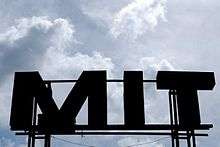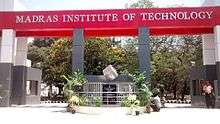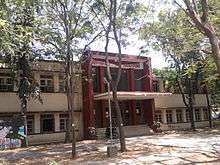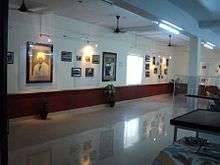Madras Institute of Technology
 | |
| Motto | In the service of India |
|---|---|
| Type | Public university |
| Established | 1949 |
| Chancellor | Banwarilal Purohit (Governor of Tamil Nadu,) |
| Vice-Chancellor | M.K.SURRAPA |
| Dean | Dr. A.Rajadurai |
| Registrar | S Ganesan |
| Undergraduates | 2000 (approx) |
| Postgraduates | 300 (approx) |
| Location | Chennai, Tamil Nadu, India |
| Campus | Urban (200 acre) |
| Colors | White, Purple |
| Nickname | MITian's |
| Website | http://www.mitindia.edu/ |
The Madras Institute of Technology (MIT) is an engineering institute located in Chromepet, Chennai (Madras), India. It is one of the four autonomous constituent colleges (University Departments) of Anna University It was established in 1949 by Chinnaswami Rajam as the first self-financing engineering institute in the country, and later it merged with Anna University. The institute was at that time an experiment in technical education, for it introduced to India new areas of specialization: aeronautical engineering, automobile engineering, electronics engineering and instrumentation technology. MIT was the first self-financing college opened in India.
The MIT is the first institute in India to offer postgraduate courses in avionics and mechatronics. The institute also has an unusual practice of "T-series" a student mentoring system by senior students The aeronautical, automobile and electronics departments of this institute are very popular and get the cream of students in Tamil Nadu, usually having very high cut-offs with seats getting filled in the early batches of first-day counselling.
The alumni of this institute include former president Dr A P J Abdul Kalam, and writer Sujatha Rangarajan. The former Vice-Chancellor of Anna University Dr P Mannar Jawahar is a former MIT-ian. The cultural festival of MIT Mitafest, is well known in the vicinity of Chromepet.[1] The institute campus is also home to AU-KBC Research Centre.
With the dawn of Independence, the need for establishing a sound technological basis for the industrial advancement of the country was realised. At this juncture in 1949, Mr Rajam Iyer donated INR 5 lakhs through the sale of his house and founded the MIT, and raised funds from people and industries for its running. Sri M K Ranganathan, Rtd Chief Engineer, became the first principal of the institute.

At a time when other engineering institutions were offering conventional courses in civil, mechanical and electrical engineering at the undergraduate level, Mr.Rajam launched the experiment of introducing for the first time in the country new areas of specialisation in Engineering, namely Aeronautical Engineering Automobile Engineering, Electronics Engineering, and Instrument Technology.MIT was started in 1949 and was offering a three-year (undergraduate programme) in Engineering for Science graduates (BSc).During the early years, the institute offered Diploma in Engineering to science graduates(DMIT). Subsequently, on the formation of Anna University in 1978, MIT became one of the constituent institutions of the university and hence, the department has also become a department of Anna University,they started awarding the Degree B.Tech,three year Engineering Degree course to (B.Sc)science graduates.Over the years, the institute has expanded its original programme and now offers undergraduate and postgraduate courses in Production Engineering, Rubber and Plastics Technology, Computer Science Engineering and Information Technology. The institute accepts students who have passed the 12th board examinations for its four-year undergraduate programme from 1996.
Instrumentation and Control did not exist in India as a subject of study in 1949. Now, this branch of applied science and technology has become important in industry, and past students of MIT now hold key positions in research and development organisations, manufacturing industries and educational institutions within the country and abroad.
Administration
Madras Institute of Technology is a constituent college of Anna University and is governed by a Chancellor, Vice-Chancellor and Registrar of the varsity. The varsity has a syndicate. The Dean is the head of the institute and oversees day-to-day administration. Each department is led by a Head of the Department (HOD). The hostels are headed by assistant executive wardens placed under an executive warden with Dean as the ex-officio warden

The academic policies are decided by the course committee, whose members include all the professors and student representatives headed by a chairman.
Madras Institute of Technology follows the credit-based system of performance evaluation and student-teacher relation, with proportional weighting of courses based on their importance. The total marks (usually out of 100) form the basis of grades, with a grade value (out of 10) assigned to a range of marks. For each semester, the students are graded by taking a weighted average of all the courses with their respective credit points. Each semester's evaluation is done independently with a cumulative grade point average (CGPA) reflecting the average performance across semesters.
The admission to the institute is through Tamil Nadu Engineering Admissions based on Unified Single Window Admission System for the first year of undergraduate courses. Most of the students from Tamil Nadu qualify from the Tamil Nadu Higher Secondary Board Examinations. Till 2006, TNPCEE was also a mandatory qualification examination along with the Higher Secondary examination.
Prominent alumni of this institute include former President Abdul Kalam and Sujatha Rangarajan.
Departments
| Department | Intra-college Symposium | Inter-college Symposium |
|---|---|---|
| Aeronautical Dept | Mach | Flight |
| Automobile Dept | Spark | Automeet |
| Computer Technology Dept | Trigger | Prayatna |
| Information Technology Dept | Mutex | Samhita |
| Electronics Dept | Apocalypse | Electrofocus |
| Electronics & Instrumentation Dept | Livebeat | Intecho |
| Production Technology Dept | Promanic | Expro |
| Rubber & Plastics Technology Dept | Spartians | Elastoplaz |
- Department of Aerospace Engineering - The Department of Aerospace Engineering was established in 1949 as faculty of Aeronautics in the Madras Institute Of Technology Campus, for furthering the cause of Aerospace Research in the newborn nation. It is the first department offering undergraduate (UG) programme in Aeronautical Engineering in India. The Department may have been leading the way in propelling indigenous research in the aerospace field and may have had competent, devoted and efficient faculty and highly sophisticated state–of–the–art laboratory facilities. The Department runs one full-time UG, three full-time post graduate (PG), one part-time UG and one part-time PG programmes. The department also offers MS(By research) and PhD research programs in various areas related to Aerospace Engineering.

- Department of Automobile Engineering - This is also one of oldest departments offered by the college since its inception. The college offers both undergraduate and postgraduate courses. The annual student intake is 60. The Head of the Department is Dr S Jayaraj and the president of AEA (Automobile Engineering Association). The Department of Automobile Engineering at MIT was started in 1949 and was offering a three-year (undergraduate programme) in Automobile Engineering for Science graduates (BSc). Subsequently, on the formation of Anna University in 1978, MIT became one of the constituent institutions of the university and hence, the department has also become a department of Anna University. The postgraduate programme was started in 1978. This is the only pioneering Institute which is offering both undergraduate and postgraduate programmes in Automobile Engineering in the whole of India, besides offering MS (by research) and PhD Programmes. From 1996 onwards a four-year B Tech undergraduate programme for students of higher secondary education is being offered. The department is involved in the programmes of the Centre for Automotive Research and Training (CART).
- Department of Electronics & Communication Engineering - The Department of Electronics Engineering was established in 1949. It has its core strength in the area of Electronics & Communication. This is the largest department of the MIT campus of Anna University, which has about 25 faculty members serving about 400 undergraduate students and 100 postgraduate students. The research areas include Communication Technologies, Wireless Communication, Network Security, Sensor Networks, Optical Communication, Avionics, Signal Processing, Image Processing & Pattern Recognition and VLSI. The department has collaborative partners from academia and industry both locally and worldwide.
- Department of Instrumentation Engineering - The Department of Instrumentation Engineering MIT Campus Anna University was established in the year of 1949. Originally the Degree was offered as B.Tech, Instrument Technology after 1978. Later it was changed as B.Tech, Instrument Engineering, three year Degree course for B.Sc Science graduates. Presently the Instrumentation Engineering Department offers Electronics and Instrumentation Engineering at UG level, 4-year Degree course for 12th class passed students from 1996 on wards, Instrumentation Engineering at PG level, and PhD / MS (by research) for both regular and Part-time scholars. The core strength of the Instrumentation Engineering Department MIT Campus, Anna University is Process Control & Instrumentation.
- Department of Information Technology- The Department of Information Technology was established in 2000. The branch of "Information Technology" has an intake strength of 120 every year (recently 2007-08 increased). The department includes an undergraduate and postgraduate programme running in parallel. It has both a full-time and part-time programme for the undergraduate programme. The research areas include Grid computing, XML technologies, Networking and connectivity protocols, cloud computing, network security and Databases.
- Department of Computer Technology- The Department of Computer Technology was established in 2010. The branch of "Computer Technology" has an intake strength of 120 every year (undergraduate). The department includes an undergraduate and postgraduate programme running in parallel. The research areas include Cloud Computing, Grid Computing, XML technologies, Networking and connectivity protocols, network security and Databases, E-learning, Multimedia, and Video Streaming.
- Department of Production Technology - The Department of Production Technology started with a three-year B Tech Production Engineering programme (for BSc graduates) in 1977 with an intake of 20 students and an ME programme in 1993. The department offers B.E. in Production Engineering and Mechanical Engineering and ME in Manufacturing Engineering, and Mechatronics Engineering. It offers part-time undergraduate programmes in the areas of Mechanical Engineering, Production Engineering and a postgraduate programme in Manufacturing Engineering. For the first time in India, a postgraduate programme in ME Mechatronics was started in 1999 with an intake of 15 students.
- Department of Rubber & Plastics Technology - The Department of Rubber & Plastics is one of the pioneering departments of MIT, keeping to the tradition of MIT in being a non-conventional course offered under the Engineering curriculum. The department was started in 1988 and offers a BTech. Degree programme in Rubber & Plastics Technology and an MTech programme in Rubber Technology. The inter-disciplinary B Tech programme boasts of successful alumni across the country in diverse Engineering fields ranging from Rubber and Plastics, Automobile Components, Mechanics as well as IT and Consulting industries besides a good number of them having proved as thriving Entrepreneurs. The department has the highest percentage of PhDs and industry experienced faculty among all the other departments of MIT.
Research centres
- Centre for Aerospace Research: The Centre for Aerospace Research (CASR) came into being in 2000 and focuses on advancing research in aerospace sciences. The centre has a design, analysis and computational capabilities to take up problems in high speed and low speed flows, structure, aero-thermal effect and composites. The applications software being regularly employed include MSC-NASTRAN, STAR-CD, CFX, I_DEAS and tascflow. For carrying out experimental studies in the thrust areas, the centre has laboratories and facilities with specialised equipment. The country's first student-developed satellite ANUSAT is designed, developed and integrated at this facility. The aerospace department includes the avionics department which designed the control software.
- Anna University - K B Chandrasekhar Research Centre (AU-KBCRC)[2]:The Anna University K B Chandrashekar Research Centre was established at the MIT Campus in May 1999 through the donation of ₹1.00 crore Dr K B Chandrasekhar, chairman and co-founder of Exodus Communications. The infrastructure includes a 256 kbit/s Internet access over a 2 Mbit/s based line, high-end server with broad-based networking. The research activities of the centre are on cryptography, network security, internet access over the power line medium and many others. In addition, the KBC Foundation has donated another ₹0.5 crore rupees towards setting up a state-of–art Java lab at the centre and ₹1.5 crore rupees for the campus networking and video conferencing facilities. One of the goals of the centre is to link value-addition to the domain-knowledge possessed by the faculty and the students of our university in diverse domains through the use of the Internet and computer software.
- , Centre for Automotive Research and Training:The Centre for Automotive Research and Training (CART), an inter-disciplinary centre, was established in the year 1997 by the University to mainly cater to the needs of the automotive industry with regard to design, research, consultancy, training and testing. The centre functions currently both at the main campus and at the MIT campus. The centre proposes to offer a postgraduate programme titled, automotive manufacturing management, which will be a highly inter-disciplinary programme mainly framed with inputs from the user industry, namely the automotive industry. The centre acts as a nodal agency interacting with automotive industries both at home and abroad and with various academic departments and centres, functioning at Anna University.
Student organisations
- Athenaeum is the general student organisation of MIT to promote co-curricular and extra-curricular activities of the student community. The word Athenaeum is derived from the name of Greek Goddess of wisdom, Athene. Athenaeum is responsible for organising the annual cultural festival, Mitafest and intra-college cultural festival Sivaranjani. It is an independent student body whose members are elected through elections every year, and are advised by a faculty member. The student office bearers include the Chairman, Treasurer, Vice Chairman, a Postgraduate student representative and representatives from every undergraduate year. In addition, the Dean of the Institute serves as the President of Athenaeum. Athenaeum also runs the annual campus magazine MITMAG.
- Computer Society of MIT - The Computer Society of MIT is a student organisation started in 1983 (called Computer Club then)[3] as a platform for the students to learn computers, when there was no specialised computer-related course in the institution. It conducts weekly sessions and periodic contests for the students of different departments with their respective needs. Over the years, the society has evolved as an active participant in the evolution and promotion of Free & Open Source Software (FOSS). A Free Software festival called 'Carte Blanche' is celebrated every year, as part of which demo's, workshops and interactions with pioneers of Free Software movement including Richard Stallman are organised. The organisation also conducts an annual intra-college tech event called 'Enigma'.
- Personality Development Association is a student organisation of MIT, with a goal of personality development among students. This association conducts 'Persofest' and the weekly aptitude tests which see active participation from the undergraduate students.
- Rotaract Club of MIT is a Rotary Club sponsored service club within the campus. Rotofest and Sparish are the main events that are a part of the club's activities.
- TEDc MIT is TED inspired club of MIT. It aims to promote and cultivate innovation among the minds of students. It is responsible for conducting Innovate, A TED Inspired Event in MIT Campus.
The institute has active National Service Scheme, National Sports Organisation (India) and Youth Red Cross chapters on its campus. Each chapter is headed by a faculty member and has a student body with an organisational set-up similar to Athenaeum. Membership and active participation in one of these organisations are mandatory for first-year undergraduate students.
| Student organisation | Intra-college | Inter-college |
|---|---|---|
| Computer Society | Enigma | Carte Blanche |
| Personality Development Association | Persofest | - |
| Youth Red Cross | - | |
| TEDc MIT | - | Innovate |
| Student organisation | odd semester | even semester |
|---|---|---|
| Rotaract Club | Rotofest (special children) | Sparish (god gifted children) |
Magazines
- MIT has an annual magazine MITMAG.
- The Personality Development Association publishes its magazine PERSOPLUS.
- Youth Red Cross publishes its magazine Vircham related to Social Awareness.
- The Computer Society publishes its magazine TECH TIMES.
- The Department of Electronics Engineering releases its annual magazine Impetus.
- The Department of Instrumentation publishes its technical magazine InsTrue.
- The Department of Production Technology releases its yearly magazine PRO-MAG.
- The Rotaract Club of MIT publishes its annual magazine RotoPlus which is a collection of art and writings from physically challenged and orphanage children.
- The students of the college started a newsletter and a writers' club named "The MIT Quill" which is becoming increasingly popular in complementing the administration and improving the relations between the administration and the students.[4] The students have also launched a website for The MIT Quill which hosts a number of articles written by their contributors (http://www.themitquill.mitindia.edu/). A page featuring individual writers that include current students and alumni is also updated regularly (http://www.themitquill.mitindia.edu/MITwriters/).
Cultural
The annual festival of the institute Mitafest is the oldest annual cultural festival of Chennai in existence today. Mitafest is the flagship event of MIT and an event of grandeur and extravaganza, one of the largest cultural festivals of Tamil Nadu drawing footfalls of more than 20,000 students from 100+ colleges for participating in 50+ events across the span of four days. It has thrived for more than 40 years and has blended along as the pride of the Institute. Famous personalities of Mitafest in the past are Indian Film Actor Kamal Haasan, famous writer, author and playwright Sujatha, personalities from the film fraternity such as Karthik (singer), Benny Dayal, Naresh Iyer, Krish (singer), HipHop Thamizha, Anuradha Sriram, etc.
Apart from this, there is also an intra-college cultural festival,namely Sivaranjani held in the Institute. Each department also has its own technical symposium.
Techfest and symposia
Apart from this, MIT presented "Asymptote 2009" along with its diamond jubilee celebrations. Asymptote-2009 was held on 9, 10 and 11 January 2009. Students from other colleges participated in the event. But this was not continued in the following years.
Every department has an intra-college and inter-college technical symposium.

Placements
All well-known core product and service companies come for recruitment and placement interviews happen at a common venue with CEG students in the Anna University - main campus.
MIT Alumni Association
The MIT Alumni Association (MITAA) was established in Chennai, in 1966. The first General Body meeting was held on 14 April 1966 and was headed by V Gopalan (I Batch, President), C J G Chandra (I Batch, VP), P S Subramanian (6th Batch, Secretary) and B Venkatraman (4th Batch, Treasurer). K Srinivasan was the dean of the institute at that time.
Similarly, even outside Chennai, there is MIT Alumni Associations which are very active (viz, at Bengaluru, at Singapore, at Dubai just to name few) in providing some sponsorships, justified and needed financial assistance and collaborate with parent MIT alumni chapter and MIT campus on the considerable regular basis. Each Alumni group have their own internal communications and are active with participations.
Notable Alumni
- A P J Abdul Kalam - 11th President of India (2002–2007)
- Sujatha Rangarajan Tamil Playwright.
- Susi Ganeshan,Director,Tamil film industry.
- Dr. K. Sivan, current chairperson of the Indian Space Research Organization
- Dr.R.N.Agarwal, Former program Director AGNI & Former Director ASL
T-series
MIT has the unusual practice of 'T-series'. This is a mentorship system and the word is said to have originated from the term Technocrat. Each new 'technocrat' of the institute is assigned to a mentor from the previous batch. He/she also inherits the complete set of 'T-seniors' from this mentor. Mentorship activities span a whole gamut of student activities starting from passing on books, counselling, monetary help (if needed), and placement preparation assistance (mock interviews, aptitude tests).
Each Technocrat will also be assigned to a 'T-number'. The 'T-number' is a combination of the student's batch number, his/her department code and his/her roll number. For example, consider a student who has joined Electronics and Instrumentation Department (Department code is 4). If he/she belongs to the batch of 2007–2011, he/she would be the 60th batch from Electronics and Instrumentation Department and hence his 'T-number' would be '604xxx', where xxx represents the person's roll number. As per the 'T-series', this technocrat's mentor would be the person with the 'T-number' '594xxx'. Thus, the T-series can be tracked back to even the first batch of students. The best part is that when alumni from earlier batches come for get-togethers years after graduating,they still make it a practice to at least know and interact with their respective 'T-juniors' from the current batches.
MIT Museum
A museum named MIT Museum[5] has been set up within the campus. The museum consists of photographs of all important events involving MIT.It also houses several newspaper coverages, books written by MITians and a replica of a glider made by the students of the 1952 batch. The museum was inaugurated by Anna University vice-chancellor Dr P Mannar Jawahar on 18 March 2011.

Popular media
The Tamil language feature film, Five Star (2002), featured in part, the academic life at MIT. It was partly shot in MIT campus (mainly Hanger-II and hostels) during a semester break, particularly for a song where many available students participated. The Director of the film, Susi Ganeshan is an MIT alumnus.
References
- ↑ "Rocking time at Mitafest". The Hindu. 22 February 2009.
- ↑ "AU-KBC Research Center". AUKBC website.
- ↑ "About Us". Archived from the original on 2013-11-10. Retrieved 15 August 2015.
- ↑ "The MIT Quill". themitquill.mitindia.edu. Retrieved 15 August 2015.
- ↑ "Museum chronicles achievements of Madras Institute of Technology". The Hindu. 20 March 2011.
External links
| Wikimedia Commons has media related to Madras Institute of Technology. |
- Madras Institute of Technology
- MITAFEST
- MITAA
- FLIGHT
- AUTOMEET
- PRAYATNA
- ELECTROFOCUS
- INTECHO
- SAMHITA
- ELASTOPLAZ
Coordinates: 12°56′53″N 80°08′23″E / 12.94810°N 80.13974°E